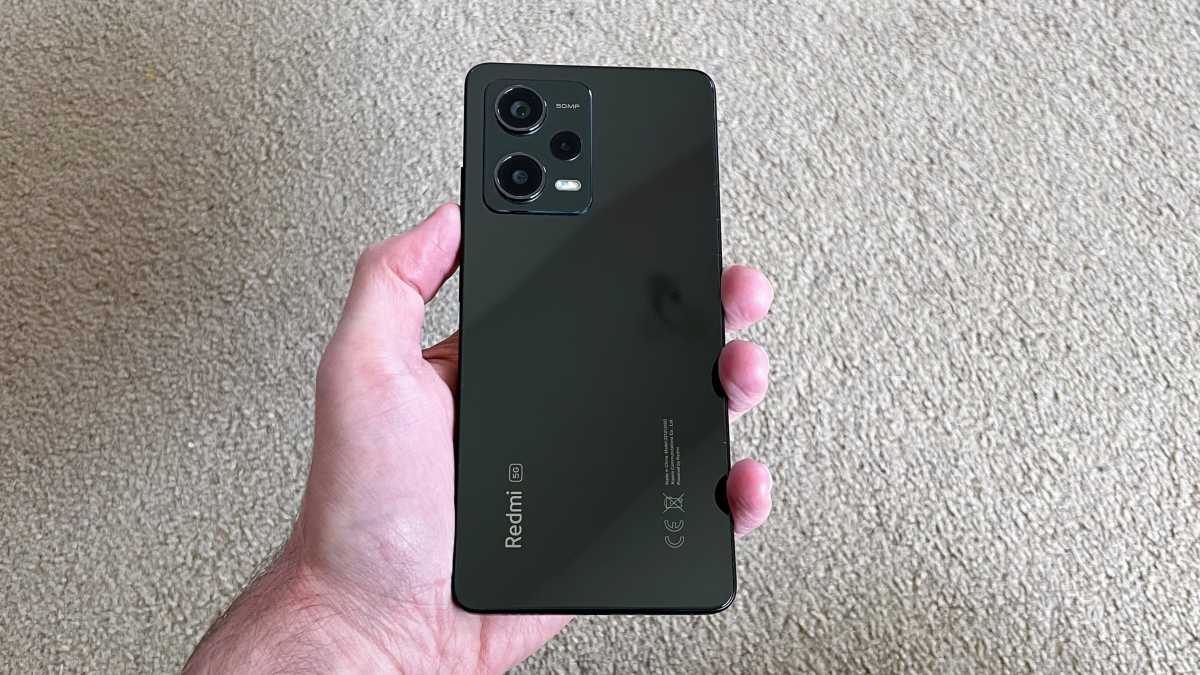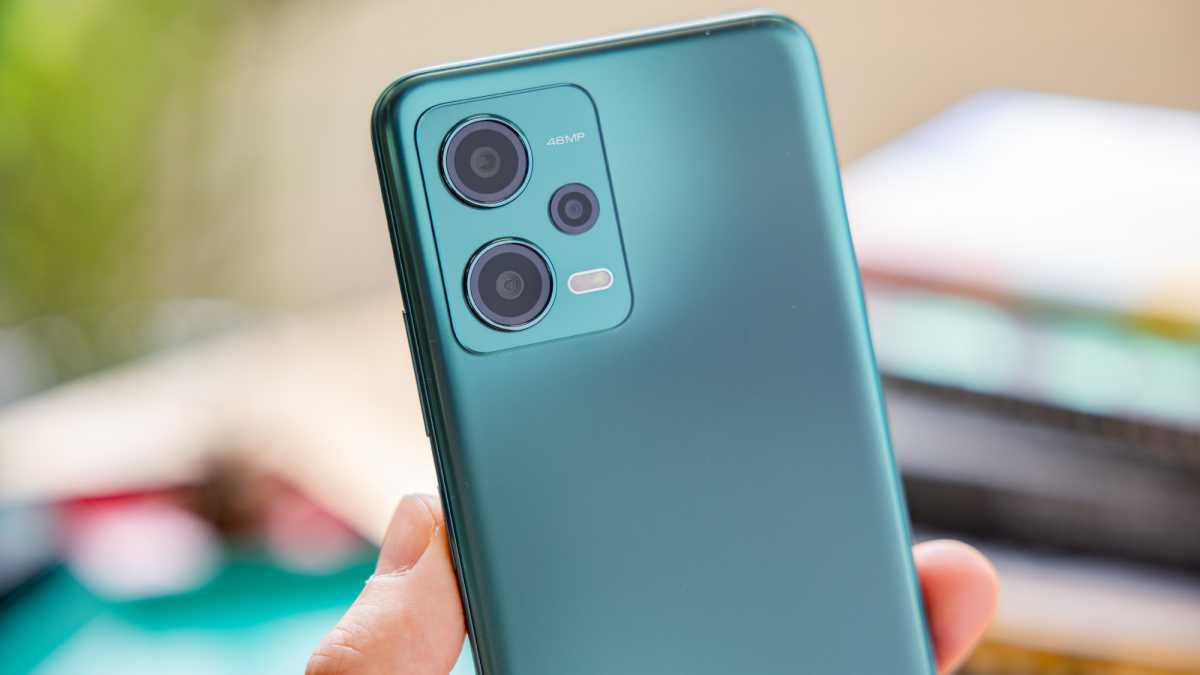If you’re looking for a great smartphone but don’t want to pay premium prices, Xiaomi has plenty of options.
The company’s Redmi sub-brand is a great place to start, and 2023’s Redmi Note 12 series saw four new phones come to the UK and Europe. The cheapest of these is the 4G Redmi Note 12, which starts at just £219/€249.
In this article, we’re focusing on the middle two in terms of price. If you have around £300/€300 to spend, should you opt for the £279/€299 Redmi Note 12 5G or step up to the £339/€399 Redmi Note 12 Pro?
Here are all the key differences between the two, which will help you decide which is right for you. If you have a slightly bigger budget, consider the Redmi Note 12 Pro+ or another mid-range phone.
Differences between Redmi Note 12 5G and Redmi Note 12 Pro
Both phones exhibit a sleek and modern design. The Redmi Note 12 5G (known from here on as simply ‘Redmi Note 12’) offers three colour options: Onyx Gray, Ice Blue, and Forest Green. On the other hand, the Redmi Note 12 Pro comes in Black, White, and Blue.
They look very similar but the actual construction is very different. The regular Redmi Note 12 is made out of plastic and slightly larger and lighter, while the heavier and more compact Redmi Note 12 Pro sports a glass back.
That makes it more durable but also a smudge and fingerprint magnet. Meanwhile, the matte plastic finish on the Redmi Note 12 doesn’t have that problem. Also, the bottom bezel of the Redmi Note 12’s screen is slightly larger than the one on the Pro model.
Both phones come with an IP53 rating, offering some resistance to dust and water splashes. While they won’t survive a full submersion, they should withstand the rigours of daily life.

Dominik Tomaszewski / Foundry
Another difference is that the Redmi Note 12 has Gorilla Glass 3 up front whereas on the Pro model that’s upgraded to more durable Gorilla Glass 5.
However, both devices feature a 6.67in OLED display with 120Hz refresh rate, ensuring smooth and vibrant visuals. However, the Redmi Note 12 Pro takes it up a notch with its HDR10+ and Dolby Vision support, making it the better choice for media consumption and gaming.
On the other hand, the display of the regular Redmi Note 12 is brighter so it will be a better choice for outdoor usage.

Anyron Copeman / Foundry
The Redmi Note 12 Pro features dual stereo speakers, with the typical downward-firing grille complemented by an additional one at the top of the phone. This proves to be a superior alternative to depending solely on the earpiece, enhancing the phone’s capability to produce remarkable audio.
Regrettably, the audio quality on the standard Redmi Note 12 can’t match that – it has just a single downward-firing speaker. While it can achieve a decent volume, it lacks bass and frequently produces a diluted sound. It is suitable for casual listening, but doesn’t offer much beyond that.
In terms of ports, there is USB-C, Dual-SIM, and an audio jack at the bottom of both models so you can always choose between a pair of wireless earbuds or standard wired earphones.

Dominik Tomaszewski / Foundry
The Redmi Note 12 is equipped with the Qualcomm Snapdragon 4 Gen 1 processor, while the Redmi Note 12 Pro features the MediaTek Dimensity 1080. Both chipsets offer solid performance, but the Dimensity 1080 in the Pro model provides a slight edge, especially in graphic-intensive tasks.
In our Geekbench 5 multi-core test, the Redmi Note 12 achieved a score of 2006 points, while the Pro model outperformed it with a score of 2221 points.
In terms of RAM and storage, the Redmi Note 12 comes with 4GB of RAM and 128GB of UFS 2.2 storage, which is expandable up to a whopping 1TB. The Redmi Note 12 Pro, on the other hand, offers 6GB of RAM and 128GB of UFS 2.2 non-expandable storage. If you need extra storage, the Note 12 is the clear winner.
Both devices have a side-mounted fingerprint sensor, plus 5G support for faster data speeds. But the Note 12 Pro has slightly upgraded Wi-Fi 6 and Bluetooth 5.2 support, compared to Wi-Fi 5 and Bluetooth 5.1 on the regular Note 12.

Anyron Copeman / Foundry
Both phones have a sizeable 5000mAh battery. However, the Redmi Note 12 Pro offers faster charging, with 67W wired charging, as opposed to the 33W wired charging of the Redmi Note 12. If you’re always on the move and need a quick battery top-up, the Pro model is a better choice.
With the Redmi Note 12, you can confidently go through an entire day without ever needing to worry about finding the nearest power outlet. On lighter days, particularly when you’re at home, it can even go up to 48 hours before requiring a recharge.
But the Redmi Note 12 Pro, it also holds up for a full day of moderate usage and can extend to two days if you use your phone only occasionally.
They may not compete with the best battery life phones, but you won’t find yourself constantly anxious about them running out of power.
It’s worth noting that neither of these phones supports wireless charging, but that’s not surprising at this price.

Dominik Tomaszewski / Foundry
Camera capabilities are always a key consideration when choosing a smartphone.
The Redmi Note 12 features a 48Mp main camera, 8Mp ultrawide, 2Mp macro and 13Mp front-facing camera. In comparison, the Redmi Note 12 Pro boasts a 50Mp main camera, 8Mp ultrawide, 2Mp macro and 16Mp front-facing camera.
On the Pro, you also get the benefit of optical image stabilization (OIS) on the main rear lens. The images both phones can capture are similar, but the Pro has the slight edge.
Below you will find photos taken with the Redmi Note 12 (first) and the Redmi Note 12 Pro (second):
Price & availability
UK and Europe customers can buy only a single variant of the Redmi Note 12 for £279/€299 directly from Xiaomi. This version features 4GB of RAM and 128GB of storage.
The global version of the Redmi Note 12 Pro is available in one version only too. This model serves as the entry-level option, providing 6GB of RAM and 128GB of storage.
You can buy it at a price of just £339/€399. The phone can be obtained directly from Xiaomi in the UK and Europe.
There are no network providers offering both of these phones on contract, but you have the option to pair it with an excellent SIM-only deals, as there are numerous attractive options available in the UK.
Verdict
When it comes to choosing between the Xiaomi Redmi Note 12 5G and Redmi Note 12 Pro, your decision should be based on your specific needs and priorities.
If you’re looking for a more budget-friendly option with expandable storage and are content with slightly less camera and charging capabilities, the Redmi Note 12 5G is an excellent choice.
On the other hand, if you’re willing to invest a bit more for a superior display, better camera features, faster charging, and improved wireless connectivity, the Redmi Note 12 Pro is the device for you.
But both phones offer a lot for their respective prices, and with OS updates until 2026 and security updates until 2028, should last a good few years.
Specs
Xiaomi Redmi Note 12:
- Android 13 w/ MIUI 14
- 6.67in Full HD+ (1080×2400) OLED display, 120Hz refresh rate
- Side-mounted fingerprint sensor
- Gorilla Glass 3 (front only)
- Qualcomm Snapdragon 4 Gen 1
- 4GB RAM
- 128GB UFS 2.2 storage (expandable up to 1TB)
- 48Mp, f/1.8 main camera
- 8Mp, f/2.2 118Ëš ultrawide camera
- 2Mp, f/2.4 macro camera
- 13Mp, f/2.45 front-facing camera
- Single speaker
- 3.5mm audio jack
- Dual-SIM
- 5G
- Wi-Fi 5
- Bluetooth 5.1
- IP53
- USB-C
- 5000mAh battery
- 33W wired charging
- 165.9 x 76.2 x 8 mm
- 188g
- Onyx Gray, Ice Blue and Forest Green colour options
Xiaomi Redmi Note 12 Pro:
- Android 13 w/ MIUI 14
- 6.67in OLED 120Hz curved display, 20:9, HDR10+, Dolby Vision
- Side-mounted fingerprint sensor
- Gorilla Glass 5 (front only)
- MediaTek Dimensity 1080
- 6GB RAM
- 128GB UFS 2.2 non-expandable storage
- 50Mp, f/1.9 main camera with OIS
- 8Mp, f/2.2 120Ëš ultrawide camera
- 2Mp, f/2.4 macro camera
- 16Mp, f/2.5 front-facing camera
- Dual stereo speakers
- Dual-SIM
- 5G
- Wi-Fi 6
- Bluetooth 5.2
- IP53
- USB-C
- 5000mAh battery
- 67W wired charging
- 163 x 76 x 8mm
- 187g
- Black, White or Blue colour options
